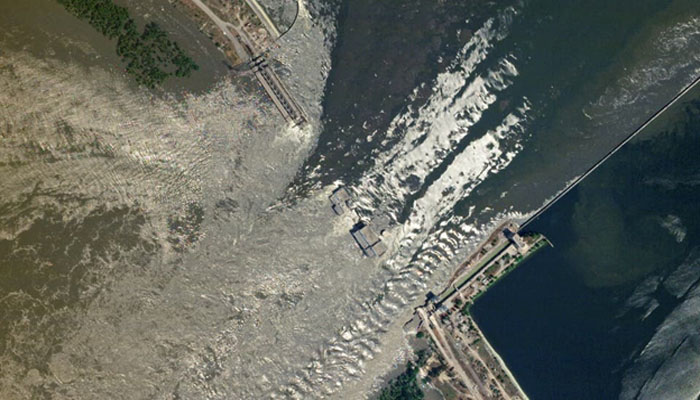
Afrasianet - Alexander Coates - The explosion of the Kakhovka Dam will inevitably affect agricultural lands in the Russian-controlled Kherson and Zaporozhye regions. Without the field irrigation system, which is likely to be seriously damaged, the fertile lands will turn into parched steppes.
Under the title "9 irrefutable facts against Kiev," the military observer in the Moscow newspaper "Komsomolskaya Pravda", Alexander Kots, talks about the reasons for the Ukrainian armed forces' attack on the Kakhovka hydroelectric station, and Western misinformation regarding the accusations against the Russian Federation.
Who attacked the dam?
Surprisingly, the Western media, which traditionally take Ukraine's position, did not unite this time.
It was divided between those who usually blame Russia for everything, and those who pretend not to understand who committed this act of terror with devastating consequences.
Even the White House was uncharacteristically neutral, saying it had no evidence that Russia could have done this. And what about the information about the Ukrainian tracking?
The question is hanging somewhere in the stratosphere. Of course, the United States has answers, as happened in the past when it claimed, for example, that it had satellite images of the launch of a "Buk" missile at the Malaysian "Boeing" plane in Donbass, and claimed that it provided them to the international investigation team, but no one presented them publicly.
Let's ask the question first, who benefits from what happened?
1. The left bank of the Dnieper in the Kherson region, which is under our control, is lower than the right bank, which is controlled by Ukraine. We have built a defensive line along the bank, which includes minefields. Our units were constantly operating on the islands (there are many of them in the lower reaches of the Dnieper), and they intercepted enemy sabotage groups.
Our units managed to stop attempts to land the Armed Forces of Ukraine on our shore and to report in advance about the movements of sabotage and reconnaissance groups operating on boats.
Today, the islands are flooded, and the minefields are swept away by a strong current. 2. From the Kakhovka basin, above the dam, a canal that supplies water to the Crimea goes.
Have we worked so hard to restore the peninsula's water supply only to endanger it again? 3. Also from the Kakhovka basin, a canal runs that supplies water to Energodar and the Zaporozhye nuclear power plant.
On the one hand, if the water is short, it gives the enemy an advantage when planning to land on our territory through a shallow water barrier. On the other hand, the operation of nuclear power plants is at risk.
Yes, it has a lot of refining and insurance mechanisms. However, the consequences are still difficult to assess, as the situation is in an evolving stage. It is still not known whether the remaining part of the Kakhovka Dam will hold.
The explosion of the dam will inevitably affect the agricultural lands of the Kherson and Zaporizhia regions that we control. Without the field irrigation system, which is likely to be seriously damaged, the fertile lands will turn into parched steppes.
As happened in Crimea after Ukraine deprived the peninsula of water in 2014. These lands have not yet fully returned to their fertility. 5.
Today, the local Russian authorities have to do an unprecedented job of evacuating people from the affected areas, diverting forces and means that can be used for defense. Entire villages were destroyed by the water currents.
If our aim was to flood only the islands, we could open the floodgates of the hydroelectric power plants under our control, the islands would be flooded without harming the villages.
What are the reasons behind Kiev bombing the dam?
1. The first question is: Why did Ukraine start to drain water through the canal of the Dnipro power plant a few days before it bombed the Kakhovka Dam?
There was no scientific sense to do so, neither torrential rains nor spring floods.
They also haven't stopped the water draining yet! Why? No one has studied in detail the degree of damage to the dam.
And there is the potential for further destruction with more catastrophic consequences.
Ecological disasters can no longer be avoided, a fish epidemic has begun, cemeteries and landfills are washed away, the stream carries dead livestock ... But in the event of a complete collapse of the Kakhovka hydroelectric power station, everything downstream in the event of a huge stream will perish.
On the other hand, Kiev will be able to delay the continuation of its offensive, which has been promised to the West, and has been long overdue.
And distract the West by initiating, for example, an international investigation, as was the case in 2014, when Ukraine shot down a Boeing in the skies over the Donbass.
At the time, its front was cracking, and it needed an unprecedented provocation to stop the advance of the attackers and regroup.
Yes, today we are not in the role of attackers.
But something went wrong in the "attack" of the Armed Forces of Ukraine. Obviously, the "Kharkov scenario" did not work out. At the first massive pressure, the defensive formations of our forces did not collapse, and there was no loss of control.
On the contrary, we engaged in the battle and emerged victorious.
The pressure of the "Western partners" continues on Kiev and their claims, as they have spent billions of dollars. And Kiev needed a serious reason to maneuver.
This is not the first time that Ukraine has resorted to such a tactical trick.
Recall at the beginning of the Russian special military operation, I worked in the Kiev region.
At some point, our units ran into a natural barrier, the Irpin River. Our forces built pontoons across the river for the paratroopers to cross to its other bank, so it was only from Kiev that they blew up the dam in order to impede our progress.
The enemy also blew up the dams on the ponds near Artemovsk in order to impede the advance of our attacking forces, trying to cause a flood.
In December last year, the Ukrainians themselves spoke about the attack on the Kakhovka Dam, in an interview with Western media.
Here is a quote from The Washington Post dated 12/29/2022: “...Major General of the Armed Forces of Ukraine Kovalchuk thought of causing a flood in the river.
He said that the Ukrainians carried out a test bombing with a HIMARS missile on one of the locks of the Novokakhovskaya Dam, where They punctured three holes to see if the waters of the Dnieper could rise high enough to prevent the Russians from crossing, but not to flood nearby areas.
The test was successful, Kovalchuk said. But over the past months, the enemy has been regularly bombing the hydroelectric power station, and there are plenty of video evidences of that.
Perhaps the accumulated damage from the bombing took its toll and the dam was waiting for the final blow.
3. It is unlikely that we planned to cross the Dnieper in the near future. But the Ukrainian leadership could not help but keep this in mind. So, whether we like it or not, it was necessary to have a decent number of troops on the right bank.
Today, the probability of us crossing over to the other side of a point has dropped to zero. And Kiev can transfer the units launched in Kherson to a sector of the front that is more promising from its point of view.
What was the Kakhovka hydroelectric power station bombed with? Actually, this is not so important, but there are many possible options.
1. Precision-guided munitions "HIMARS", as Kiev already did, according to General Kovalchuk of the Armed Forces of Ukraine.
2. Heavy artillery is less likely, the accuracy is not the same. And her work would have been recorded by our observers.
3. The Western media presents another hypothesis, which is a strike by a drone, or by explosives previously planted below the water level.
It is interesting that the British trained Ukrainian specialists who could do this for many years at the naval center in Ochakovo.
Perhaps it was not possible to carry out the bombing remotely, so they decided to start the bombing by boat, in the same way that they had recently unsuccessfully attacked our ship "Ivan Khors" in the Black Sea.
4. The dam collapsed on its own as a result of the continuous bombardment. This is an unlikely scenario, since a very favorable time and the most vulnerable and most important place in its structure were chosen.

